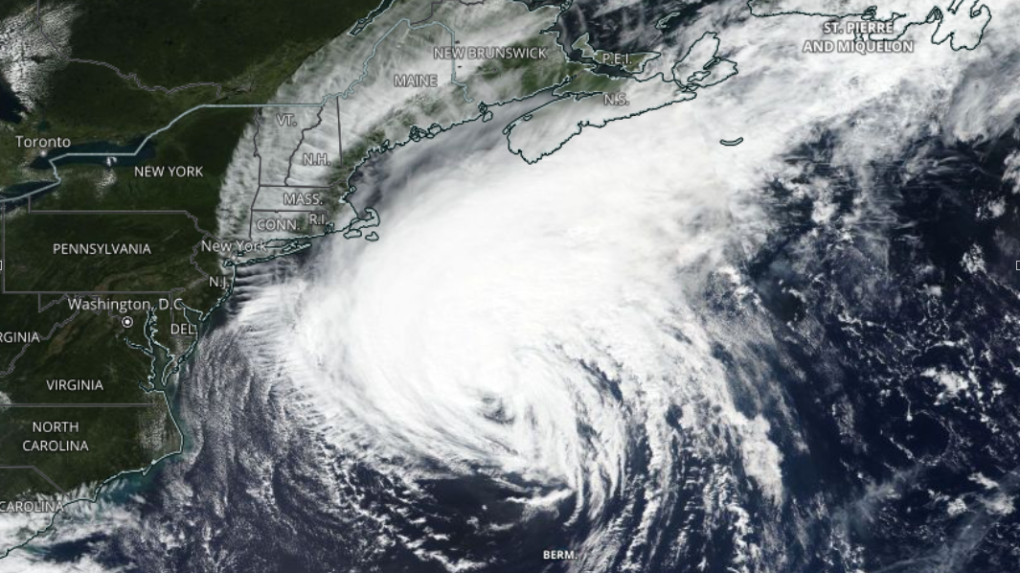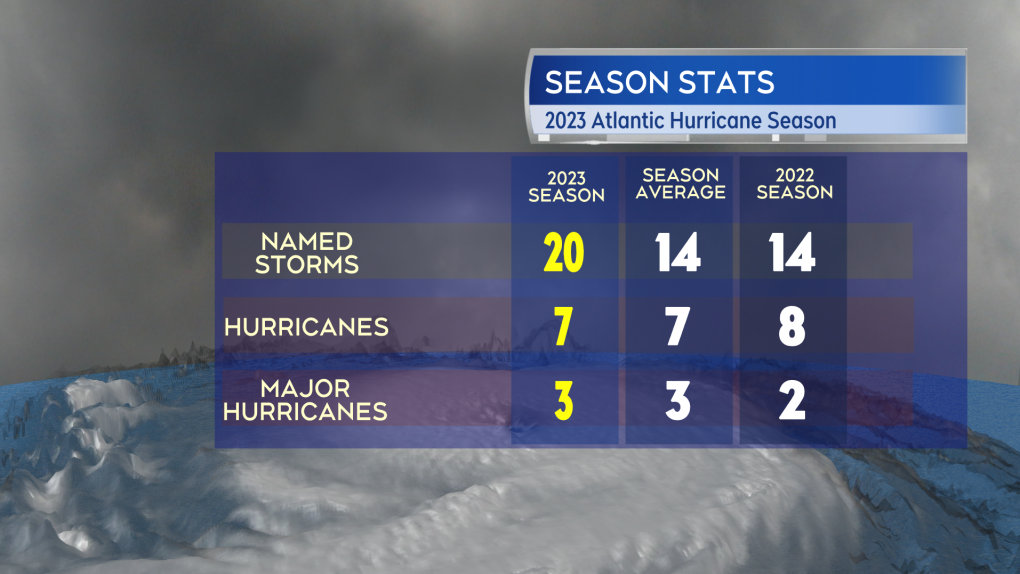2023 Atlantic hurricane season ends; finishes 4th for most-named storms
 NASA satellite imagery showing an approaching Lee moving northward past Bermuda. Lee would eventually make landfall in the southwest of Nova Scotia as a post-tropical storm on Sept. 16.
NASA satellite imagery showing an approaching Lee moving northward past Bermuda. Lee would eventually make landfall in the southwest of Nova Scotia as a post-tropical storm on Sept. 16.
The 2023 Atlantic hurricane season comes to an end on Thursday.
The National Oceanographic and Atmospheric Association of the United States says in a statement they rank the season as fourth for most-named storms in a year.
The final tally includes 20 named storms, seven of which obtained hurricane strength, and three of those seven became a major hurricane, which is defined as Category 3 or higher.
 Hurricane Lee was the only one to impact the Maritimes. Lee made landfall as a strong post-tropical storm on Sept. 16. Not nearly as destructive as Fiona a year prior, there were nonetheless associated power outages and instances of localized flooding due to heavy rain with Lee. The region also had some weather contributed by the remnants of tropical storm Phillipe. Phillipe became post-tropical well to the south of the Maritimes, but, with the remnants combining with a weather front out of the west, moved through as some heavy rain and gusty winds Oct. 7 into 8.
Hurricane Lee was the only one to impact the Maritimes. Lee made landfall as a strong post-tropical storm on Sept. 16. Not nearly as destructive as Fiona a year prior, there were nonetheless associated power outages and instances of localized flooding due to heavy rain with Lee. The region also had some weather contributed by the remnants of tropical storm Phillipe. Phillipe became post-tropical well to the south of the Maritimes, but, with the remnants combining with a weather front out of the west, moved through as some heavy rain and gusty winds Oct. 7 into 8.
 NASA satellite imagery showing an approaching Lee moving northward past Bermuda. Lee would eventually make landfall in the southwest of Nova Scotia as a post-tropical storm on Sept. 16.
NASA satellite imagery showing an approaching Lee moving northward past Bermuda. Lee would eventually make landfall in the southwest of Nova Scotia as a post-tropical storm on Sept. 16.
Initially forecast to be a near-normal season in May, that was revised in August to be an active season expected by the NOAA. The reason for the revisions given was the presence of much warmer than normal ocean waters and lower wind shear. Warmer ocean waters made more energy available to developing storms and lower wind shear allowed those storms to develop the structure necessary to sustain themselves long enough to become tropical storms or hurricanes.
This was a bit of surprise as in a typical El Nino year enough wind shear over the Atlantic is often produced to help restrict the development of tropical storms and hurricanes. In fact, Matthew Rosencrans, lead hurricane forecaster at the NOAA, noted “the Atlantic basin produced the most named storms of any El Nino influenced year in the modern record.”
 The list of names used for the tropical storms and hurricanes of the 2023 Atlantic hurricane season.
The list of names used for the tropical storms and hurricanes of the 2023 Atlantic hurricane season.
The 2024 Atlantic hurricane season will begin on June 1, 2024. The NOAA will likely have their first prediction for that season issued around May 25, 2024.
CTVNews.ca Top Stories

opinion Tom Mulcair: Prime Minister Justin Trudeau's train wreck of a final act
In his latest column for CTVNews.ca, former NDP leader and political analyst Tom Mulcair puts a spotlight on the 'spectacular failure' of Prime Minister Justin Trudeau's final act on the political stage.
B.C. mayor gets calls from across Canada about 'crazy' plan to recruit doctors
A British Columbia community's "out-of-the-box" plan to ease its family doctor shortage by hiring physicians as city employees is sparking interest from across Canada, says Colwood Mayor Doug Kobayashi.
Baseball Hall of Famer Rickey Henderson dead at 65, reports say
Rickey Henderson, a Baseball Hall of Famer and Major League Baseball’s all-time stolen bases leader, is dead at 65, according to multiple reports.
Arizona third-grader saves choking friend
An Arizona third-grader is being recognized by his local fire department after saving a friend from choking.
New rules clarify when travellers are compensated for flight disruptions
The federal government is proposing new rules surrounding airlines' obligations to travellers whose flights are disrupted, even when delays or cancellations are caused by an "exceptional circumstance" outside of carriers' control.
Germans mourn the 5 killed and 200 injured in the apparent attack on a Christmas market
Germans on Saturday mourned the victims of an apparent attack in which authorities say a doctor drove into a busy outdoor Christmas market, killing five people, injuring 200 others and shaking the public’s sense of security at what would otherwise be a time of joy and wonder.
Blake Lively accuses 'It Ends With Us' director Justin Baldoni of harassment and smear campaign
Blake Lively has accused her 'It Ends With Us' director and co-star Justin Baldoni of sexual harassment on the set of the movie and a subsequent effort to “destroy' her reputation in a legal complaint.
London Ont. Liberal MPs say that Trudeau is taking time to reflect on his future
Both of London’s Liberal MPs are choosing their words carefully when it comes to their party's leadership future. They were asked about the situation in Ottawa at Friday's housing announcement in London.
Albania to close TikTok for a year blaming it for promoting violence among children
Albania's prime minister said Saturday the government will shut down the video service TikTok for one year, blaming it for inciting violence and bullying, especially among children.


































